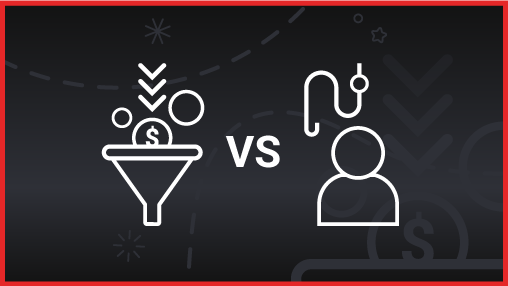Demand generation and demand capture are two critical yet distinct components of an effective marketing and sales strategy for B2B companies. While both aim to drive revenue growth, they approach this goal from different angles. This article will explore the nuances between demand generation and demand capture, their respective goals, tactics, and benefits.
By understanding the key differences and synergies, businesses can craft a comprehensive demand strategy that nurtures prospects through the entire buyer’s journey, ultimately boosting conversions and maximizing revenue potential.
What is demand generation?
Demand generation is the process of creating awareness and interest in a company’s products or services within a target audience. The primary goal is to attract new customers by capturing their attention and nurturing them through the early stages of the buyer’s journey.
Demand generation focuses on building brand awareness, establishing thought leadership, and educating potential customers about their pain points and the solutions available. It involves a range of inbound marketing strategies, such as content marketing, social media marketing, SEO, and email campaigns.
Demand generation goals and KPIs
The primary goals of demand generation campaigns are to build awareness of your brand, products, and solutions among a broad audience that may not be actively looking to make a purchase yet. Key performance indicators (KPIs) for demand gen initiatives tend to focus on top-of-funnel metrics like:
-
- Website traffic
- Social media engagement (likes, shares, comments)
- Email list growth
- Content downloads
- Brand reach and impressions
The idea is to get your company’s name and offerings in front of as many potential future buyers as possible through compelling content, thought leadership, advertising, and other marketing activities. Success is measured more by engagement metrics rather than immediate conversions or sales.
Demand generation tactics and platforms
Demand generation relies on a variety of inbound marketing tactics to attract interest and build awareness among potential buyers. Common demand gen tactics include:
-
- Content marketing: Creating and distributing valuable content assets like blog posts, whitepapers, ebooks, webinars to attract prospects and establish expertise
- SEO: Optimizing website content and structure to improve visibility and ranking for relevant search queries
- Social media marketing: Engaging audiences through social platforms like LinkedIn and X by sharing content, insights and building brand presence
- Email marketing: Nurturing prospect relationships through educational email campaigns and newsletters
- Paid advertising: Using paid channels like Google Ads and social media ads to amplify content reach and drive website traffic
- Events and webinars: Hosting virtual or in-person events like webinars and conferences to share thought leadership and generate leads
Key demand gen platforms include marketing automation tools, CRM systems, social media management tools, SEO software, content creation/optimization tools and analytics platforms to measure the effectiveness of campaigns.
What is demand capture?
Demand capture refers to the process of converting existing demand or interest in your products or services into tangible leads and sales. It focuses on targeting audiences who are already actively researching solutions that your company can provide. Interestingly, research indicates that only about 5% of your addressable market is actively looking to buy a product or service. Therefore, it’s critical to identify and target this 5%, where demand capture strategically comes into play.
-
- Demand capture operates further down the marketing funnel compared to demand generation. It engages prospects who have already indicated interest and buying intent, with the objective of efficiently turning that existing demand into closed sales.
Demand capture goals and KPIs
The primary goals of demand capture are to convert existing demand into tangible business results like sales inquiries, qualified leads, and revenue. Unlike demand generation which is focused on building awareness, demand capture tactics target audiences who are already actively researching and seeking out solutions in your product/service category.
Key KPIs for measuring the success of demand capture initiatives include:
-
- Conversion rates: Tracking conversion rates on high-intent channels like email marketing, paid search and retargeting ads. Conversion rates measure what percentage of your demand capture audiences are taking desired actions
- Click-Through Rates (CTRs): Analyzing CTRs on demand capture ads and campaigns reveals how effectively you’re capturing interest from in-market audiences
- Sales/marketing qualified lead volume: Demand capture should increase the number of leads marketing passes to sales, as well as boost sales’ share of marketing-generated leads
- Marketing-sourced pipeline & revenue: Ultimately, effective demand capture correlates with a higher percentage of revenue stemming from marketing-driven sources
- ROI: Calculating the ROI of demand capture spend by comparing program costs to the resultant sales pipeline and revenue
Demand capture KPIs are focused on bottom-of-funnel metrics that connect marketing efforts to tangible business impacts like leads, opportunities, and revenue. Consistent measurement of these KPIs guides optimization of demand capture tactics.
Demand capture tactics and platforms
Demand capture tactics are focused on targeting prospects who have already shown interest in your product or service offering. The goal is to convert this existing demand into tangible leads and sales opportunities. Common demand capture tactics include:
-
- Content syndication: A tactical content marketing channel that uses gated lead magnets to generate leads that have completed a form. Targeting emails focusing on individuals already indicating intent will increase the quality of the leads captured.
- Search engine marketing: Paid search ads on platforms like Google Ads allow you to reach prospects actively searching for solutions you provide. Highly targeted keyword campaigns can drive qualified traffic to relevant landing pages
- Retargeting ads: These display ads follow prospects who have previously visited your website as they browse other sites, keeping your brand top-of-mind. Retargeting can effectively re-engage interested prospects
- Social media advertising: Platforms like LinkedIn offer precise targeting options to put your promoted content in front of specific professional audiences that fit your ideal customer profile
- Account-based marketing: ABM aligns personalized marketing and sales efforts towards named target accounts that are a great fit for your solutions. Content, ads, and outreach are customized for each high-value account
- Marketing automation: Nurture existing leads with automated email campaigns and tailored content based on their stage in the buyer’s journey. Marketing automation tools enable efficient lead nurturing at scale
Demand generation vs demand capture: Key differences
| Aspect | Demand Generation | Demand Capture |
| Goal | Attract and nurture potential buyers to sales-readiness | Convert existing prospects evaluating options |
| Tactics | Inbound marketing (content marketing, SEO, social media, webinars) | Outbound strategies (paid advertising, email, sales outreach) |
| Strategy | Long-term mindshare building | Short-term active demand conversion |
| Approach | Developing future demand | Capitalizing on current demand |
| Metrics | Top-of-funnel KPIs (website traffic, content engagement, lead volume) | Bottom-of-funnel KPIs (sales qualified leads, opportunities, deal velocity, revenue, ROI) |
| Synergy | Foundational role in nurturing leads | Capturing and converting ready-to-buy leads |
While both demand generation and demand capture aim to drive revenue for a business, they take fundamentally different approaches. Demand generation focuses on creating awareness and interest in a product or service among a broad audience, many of whom may not even realize they have a need yet. In contrast, demand capture targets prospects who are already actively researching solutions and are closer to making a purchase decision.
Demand generation casts a wide net through inbound marketing tactics like content marketing, SEO, social media, webinars, and more. The goal is to attract potential buyers early in their journey and nurture them until they are sales-ready. Demand capture, on the other hand, uses more direct outbound strategies like paid advertising, email marketing, and sales outreach to convert the existing pool of prospects already evaluating options.
Another key distinction lies in the metrics used to measure success. Demand generation tends to track top-of-funnel KPIs like website traffic, content engagement, lead volume, and brand awareness. Demand capture, being focused on the bottom of the funnel, prioritizes metrics like sales qualified leads, opportunities created, deal velocity, and ultimately revenue and ROI.
While demand generation plays the long game of building mindshare, demand capture is laser-focused on short-term conversion of the active demand. An effective marketing strategy needs to strike the right balance between developing future demand and capitalizing on current demand. The two approaches are complementary rather than competing philosophies.
Benefits of demand generation
Demand generation is pivotal for businesses aiming to foster long-term growth and construct a robust sales funnel. Here are the key perks:
-
- Enhanced brand awareness and market reach: Techniques like content marketing, social networking campaigns, SEO, and other inbound methods can propel your brand and offerings into the limelight, seizing the attention of a broader pool of prospects
- Early prospect engagement: By kicking off interactions in the buyers’ awareness phase, demand gen allows businesses to educate and nurture potential customers from the outset, positioning themselves as industry thought leaders. This nurtures a seamless progress into sales-readiness and paves the way for more precise lead qualification
- Actionable data insights: Leveraging data gained from tracking website traffic, engagement, and lead sources, firms acquire a richer comprehension of their target demographics—understanding their challenges, preferences, and actions. This information is a gold mine for refining marketing initiatives and elevating the customer journey
- Higher quality leads for sales: Demand gen campaigns yield a stream of well-informed, sales-qualified leads who are already acquainted with what the company has in store. This familiarity often culminates in better conversion rates and a more streamlined, effective sales cycle
Successful demand generation builds the groundwork for ongoing revenue expansion by perpetually replenishing the sales pipeline with fresh leads.
Benefits of demand capture
Demand capture efforts are focused on converting existing demand into tangible leads, opportunities, and revenue. The primary benefits include:
-
- Higher conversion rates: By targeting audiences already actively seeking your solutions, demand capture tactics can achieve much higher conversion rates compared to broader demand generation activities
- Increased sales productivity: Demand capture nurtures sales-ready leads, allowing sales teams to focus their efforts on the hottest prospects and accelerating the path to purchase
- Improved revenue predictability: With a consistent pipeline of inbound demand, demand capture strategies enable better revenue forecasting and predictability
- Tighter marketing and sales alignment: Demand capture requires close coordination between marketing and sales to effectively engage and convert the ready-to-buy prospects
- Reduced customer churn: By engaging existing demand, demand capture helps acquire customers who are a natural fit for your products/services, leading to higher satisfaction and lower churn
Overall, demand capture maximizes the return on your demand generation investments by efficiently converting the existing interest into closed business.
Synergies between demand generation and demand capture
Demand generation and demand capture are distinct yet highly complementary strategies. Their combination is crucial for an effective B2B marketing approach, integrating both broad top-of-funnel reach and targeted engagement with in-market prospects.
Demand generation establishes a foundation by creating brand awareness, educating potential customers, and generating interest in offerings. It populates the top of the marketing funnel with prospects ready for engagement. Demand capture follows, with targeted initiatives and sales endeavours to convert the most interested leads into customers.
Understanding prospects’ challenges, buying processes, and content preferences allows for tailored messaging and optimized conversion tactics. By focusing retargeting efforts on the most engaged prospects, demand capture can be more effective.
On the other hand, the analytics from demand capture provide feedback on the most productive lead sources and demand generation channels, guiding strategic investment in the most successful activities. Leveraging a unified tech stack for data across the demand waterfall optimizes these collaborative dynamics.
8 tips for integrating demand generation and demand capture strategies
Integrating demand generation and demand capture into a cohesive strategy is crucial for maximizing marketing effectiveness and driving sustainable business growth. Here are some tips for creating a holistic approach:
- Align teams and processes: Ensure close collaboration between your marketing and sales teams. Streamline processes to enable a seamless transition from generating awareness to capturing demand and closing deals
- Map the customer journey: Develop a comprehensive understanding of your target audience’s journey, from initial awareness to purchase and beyond. Align your demand strategies with each stage to deliver a consistent and compelling experience
- Leverage data and insights: Gain insights into your audience’s behavior, preferences, and pain points. This intelligence will inform the development of targeted demand generation and capture tactics
- Optimize content strategy: Develop a content strategy that caters to different stages of the buyer’s journey. Create a mix of educational, thought-leadership, and product-focused content to support both demand generation and capture objectives
- Implement lead scoring: Develop a lead scoring system that accurately identifies and prioritizes sales-ready leads. This will enable your sales team to focus on the most promising opportunities generated through demand capture efforts
- Nurture and retarget: Implement lead nurturing campaigns to keep prospects engaged and move them through the funnel. Retarget those who have shown interest but haven’t converted, using personalized content and offers
- Use automation: Implement marketing automation tools to streamline processes, personalize communications, and deliver targeted content to the right audience at the right time, based on their behavior and preferences
- Continuously refine and optimize: Regularly analyze campaign performance data, customer feedback, and market trends to refine your strategies and tactics. Embrace an agile approach, continuously optimizing your demand efforts for better results
By integrating demand generation and demand capture into a cohesive strategy, you can effectively attract, nurture, and convert prospects, driving sustainable business growth and maximizing the return on your marketing investments.
Maximize growth. Capture demand efficiently
Transform your approach to marketing with our targeted Demand Generation service. Drive awareness, interest, and engagement with potential buyers by creating opportunities that resonate with your ideal audience. Through our enriched buyer education platform, Insights for Professionals, and strategic partnerships with leading data experts, we ensure your message reaches the right people at the right time.
Leverage actionable insights and precise data to define your Ideal Customer Profile (ICP), while building long-term relationships with engaged prospects. Our service supports your marketing efforts through tailored, multi-channel campaigns designed to nurture leads and create a sustained flow of interest.
With our advanced lead generation strategies, including a robust verification process powered by Machine Learning and our specialized QA team, we ensure high-quality leads are delivered seamlessly to your Marketing Automation Platform and sales teams.
Our cost-effective, scalable CPL model focuses on generating High-Quality Leads (HQLs) to accelerate your B2B marketing success and drive meaningful pipeline growth.
Discover how our demand generation service can transform your lead nurturing and growth strategy. Contact one of our representatives today.






